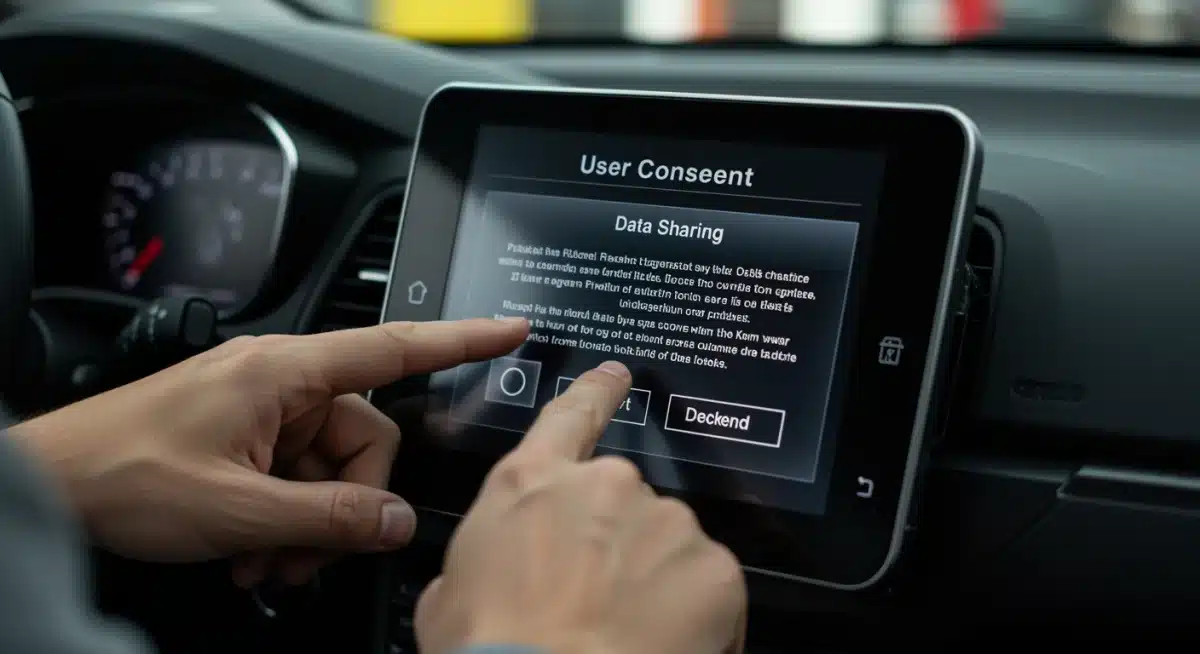US Vehicle Data Privacy Regulations 2026: Manufacturer Compliance

The latest federal regulations on vehicle data privacy mandate significant changes for US manufacturers by 2026, focusing on enhanced consumer control, transparent data practices, and robust cybersecurity to safeguard sensitive information collected from connected vehicles.
US Vehicle Data Privacy regulations are rapidly evolving, with significant new federal mandates set to reshape how American automotive manufacturers handle sensitive driver and vehicle data by 2026. This comprehensive update delves into the specifics of these recent developments, outlining the critical implementations manufacturers must undertake and the broader implications for the industry and consumers alike.
Understanding the New Federal Mandates for Vehicle Data
The landscape of vehicle data collection has grown exponentially with the rise of connected cars, generating vast amounts of information ranging from location and driving behavior to biometric data. Recognizing the potential privacy risks, federal authorities have stepped in to establish clearer guidelines. These new mandates aim to standardize data handling practices across the US automotive industry, ensuring a consistent level of protection for consumers.
The core of these regulations centers on establishing clear frameworks for data collection, storage, usage, and sharing. Manufacturers are now tasked with not only understanding these complex requirements but also integrating them into their vehicle designs, software, and operational procedures well before the 2026 deadline. This proactive approach is crucial, given the intricate nature of modern vehicle systems.
Key Principles Guiding the Regulations
- Transparency: Manufacturers must clearly inform consumers about what data is collected, why it is collected, and how it will be used.
- Consent: Obtaining explicit and informed consent from vehicle owners and drivers for data collection and sharing is paramount.
- Data Minimization: Only data strictly necessary for the stated purpose should be collected.
- Security: Robust cybersecurity measures must be implemented to protect collected data from unauthorized access, breaches, and misuse.
These principles are not merely suggestions; they form the bedrock of the new federal framework, demanding a fundamental shift in how manufacturers approach data management. Compliance will require significant investment in technology, legal expertise, and consumer education.
The Scope of Data Affected: What Information Is Under Scrutiny?
The new regulations cast a wide net over the types of data collected by modern vehicles. This includes, but is not limited to, telematics data, infotainment system usage, diagnostic information, location tracking, and even biometric data collected through in-car sensors. The sheer volume and sensitivity of this information necessitate stringent oversight.
For US manufacturers, identifying all data points collected by their vehicles is the first critical step towards compliance. This often involves detailed audits of existing systems and forward-looking assessments of future vehicle technologies. The challenge lies in the dynamic nature of vehicle data, which can change with software updates and the introduction of new features.
Categories of Vehicle Data Impacted
- Personal Driving Data: Speed, acceleration, braking patterns, route history, and frequency of travel.
- Vehicle Performance Data: Engine diagnostics, fuel consumption, tire pressure, and maintenance alerts.
- Infotainment and Connectivity Data: App usage, browser history, call logs (if integrated), and voice command recordings.
- Location Data: Real-time GPS tracking and historical location records.
- Biometric Data: If advanced driver monitoring systems incorporate facial recognition or eye-tracking.
Manufacturers must establish clear data inventories, mapping out where each piece of data originates, how it is processed, and who has access to it. This granular understanding is essential for building a compliant data privacy infrastructure that addresses the full scope of the regulations.
Implementation Deadlines and Key Milestones for 2026
The 2026 deadline might seem distant, but the complexity of implementing these regulations means manufacturers must act with urgency. The timeline involves several critical phases, from initial policy development and technological upgrades to extensive testing and validation. Delaying these efforts could result in significant penalties and reputational damage.
Federal agencies have indicated that they expect to see demonstrable progress leading up to 2026, not just a last-minute scramble. This phased approach allows manufacturers to address challenges incrementally and ensure their systems are robust and fully compliant by the effective date. The focus is on a comprehensive, systemic overhaul rather than superficial adjustments.
Critical Implementation Phases
- Phase 1 (2024-2025): Policy and System Design: Developing internal data governance policies, designing consent mechanisms, and architecting secure data infrastructure.
- Phase 2 (2025-2026): Technology Integration and Testing: Implementing new software, hardware, and cybersecurity protocols; conducting rigorous testing for compliance and vulnerabilities.
- Phase 3 (Mid-2026): Full Compliance and Auditing: Ensuring all systems are operational and compliant; preparing for external audits and ongoing monitoring.
Manufacturers must prioritize a multidisciplinary approach, involving legal teams, engineering departments, IT security, and customer relations, to navigate the intricate path to full compliance. The success of these implementations will largely depend on clear communication and collaborative efforts across the organization.

Consumer Rights and Consent Mechanisms: A New Era of Control
A cornerstone of the new federal regulations is the empowerment of consumers, granting them greater control over their vehicle data. This translates into explicit requirements for manufacturers to develop intuitive and accessible consent mechanisms. Drivers will have the right to know what data is being collected, how it’s used, and crucially, the ability to opt-in or opt-out of specific data collection practices.
This shift demands a rethinking of user interfaces and in-car notifications. Generic terms of service will no longer suffice; instead, manufacturers must provide clear, granular options for data sharing, ensuring that consent is truly informed and freely given. The goal is to build trust through transparency, allowing consumers to make conscious decisions about their digital footprint on the road.
Essential Consumer Rights Under the New Regulations
- Right to Access: Consumers can request access to the data collected about them.
- Right to Rectification: The ability to correct inaccurate or incomplete data.
- Right to Deletion: In certain circumstances, consumers can request the deletion of their data.
- Right to Opt-Out: The power to refuse or withdraw consent for specific data collection or sharing.
Manufacturers must design systems that not only facilitate these rights but also make them easily discoverable and actionable for the average vehicle owner. This user-centric approach to data privacy will distinguish compliant manufacturers and build consumer loyalty in an increasingly data-conscious market.
Challenges and Opportunities for US Manufacturers
Complying with the new US Vehicle Data Privacy regulations presents a dual landscape of significant challenges and promising opportunities for manufacturers. The financial investment in new technologies, legal counsel, and personnel training will be substantial. Integrating these changes into complex global supply chains and product development cycles adds another layer of difficulty.
However, manufacturers who embrace these regulations proactively stand to gain a competitive edge. Demonstrating a strong commitment to data privacy can enhance brand reputation, foster consumer trust, and differentiate products in a crowded market. It also provides an opportunity to innovate in secure data management and create new privacy-centric features that resonate with modern consumers.
Primary Challenges
- Technological Overhaul: Upgrading legacy systems and integrating new privacy-by-design principles into vehicle architecture.
- Legal Complexity: Navigating varying state and federal privacy laws, ensuring comprehensive compliance.
- Consumer Education: Effectively communicating complex data practices to consumers in an understandable manner.
- Cybersecurity Risks: Continuously defending against evolving cyber threats to protect sensitive data.
Strategic Opportunities
- Enhanced Brand Trust: Becoming a leader in data privacy can significantly boost consumer confidence.
- Competitive Differentiation: Offering superior data privacy features can attract discerning buyers.
- Innovation in Data Management: Developing cutting-edge solutions for secure data handling and consent.
- Reduced Legal Risks: Proactive compliance can mitigate future legal challenges and penalties.
Ultimately, the journey to 2026 will test manufacturers’ adaptability and commitment to ethical data practices. Those who view these regulations as an opportunity for improvement rather than just a burden are likely to thrive in the evolving automotive landscape.
The Role of Cybersecurity in Protecting Vehicle Data
At the heart of any effective data privacy framework is robust cybersecurity. The new federal regulations place a strong emphasis on protecting vehicle data from unauthorized access, breaches, and cyberattacks. This means manufacturers must implement state-of-the-art encryption, intrusion detection systems, and secure data storage solutions across their entire data ecosystem, from the vehicle itself to backend servers.
The interconnected nature of modern vehicles makes them potential targets for cybercriminals. A single vulnerability could expose vast amounts of personal and sensitive information. Therefore, a continuous, adaptive approach to cybersecurity is paramount, involving regular audits, penetration testing, and rapid response protocols to address emerging threats. This is not a one-time fix but an ongoing commitment.
Key Cybersecurity Measures Required
- End-to-End Encryption: Securing data transmission between the vehicle and cloud, and within internal systems.
- Access Controls: Implementing strict authentication and authorization protocols for data access.
- Threat Detection and Response: Deploying advanced systems to identify and mitigate cyber threats in real-time.
- Secure Software Development: Integrating security best practices throughout the vehicle software development lifecycle.
- Incident Response Planning: Developing clear procedures for handling data breaches and notifying affected parties.
For US manufacturers, investing in cybersecurity is not just about compliance; it’s about safeguarding their customers’ privacy and maintaining the integrity of their products. A strong security posture is a non-negotiable element of the new US Vehicle Data Privacy landscape.

Future Outlook: Beyond 2026 and Continuous Evolution
While 2026 marks a significant milestone for federal regulations on vehicle data privacy, it is by no means the end of the journey. The automotive industry is characterized by rapid technological advancement, meaning data collection capabilities will continue to evolve, and with them, the need for adaptive regulatory frameworks. Manufacturers must prepare for continuous monitoring, updates, and potential new mandates in the years to come.
The initial implementation of these regulations will likely provide valuable insights into their effectiveness and areas for improvement. Federal agencies will continue to observe industry practices and consumer feedback, potentially leading to refinements or expansions of the current rules. Staying agile and informed about these ongoing developments will be crucial for long-term compliance and maintaining a competitive edge.
Anticipated Future Developments
- Harmonization with Global Standards: Increased alignment with international data privacy laws like GDPR.
- Emerging Technologies: Regulations adapting to autonomous vehicles, V2X communication, and advanced AI systems.
- Increased Enforcement: Stricter penalties and more frequent audits for non-compliance.
- Consumer Advocacy: Growing demand from consumers for even greater data control and transparency.
The automotive sector’s proactive engagement with policymakers and privacy advocates will be vital in shaping a sustainable and secure future for vehicle data. Manufacturers who contribute to these ongoing discussions will not only ensure compliance but also help define the ethical standards of connected mobility.
Key Point |
Brief Description |
|---|---|
2026 Deadline Significance |
Mandatory implementation of new federal vehicle data privacy regulations for US manufacturers. |
Core Regulatory Pillars |
Transparency, explicit consent, data minimization, and robust cybersecurity. |
Consumer Empowerment |
Rights to access, rectify, delete, and opt-out of specific data collection and sharing. |
Manufacturer Impact |
Requires significant investment in technology and legal compliance, offering opportunities for trust building. |
Frequently Asked Questions About Vehicle Data Privacy Regulations
▼
The primary goals are to enhance consumer control over personal vehicle data, ensure transparency in data collection and usage, mandate robust cybersecurity measures, and standardize data handling practices across US automotive manufacturers to protect sensitive information.
▼
The regulations cover a broad spectrum, including personal driving data (speed, location), vehicle performance diagnostics, infotainment system usage, and any biometric data collected. Manufacturers must identify and secure all data points to ensure comprehensive compliance.
▼
It means manufacturers must clearly explain what data will be collected and how it will be used, then obtain a clear, unambiguous agreement from the vehicle owner or driver. This moves beyond vague terms and conditions to specific, granular consent options.
▼
Manufacturers face challenges such as significant technological overhauls, navigating complex legal landscapes, effectively educating consumers about their data rights, and continually fortifying cybersecurity defenses against evolving threats. These require substantial investment and strategic planning.
▼
Proactive compliance can significantly enhance brand reputation, build greater consumer trust, and provide a competitive advantage in the market. It also fosters innovation in secure data management and reduces potential legal liabilities and financial penalties associated with non-compliance.
What this means
The upcoming federal regulations on US Vehicle Data Privacy by 2026 represent a pivotal moment for the automotive industry. Manufacturers are compelled to fundamentally rethink their approach to data, moving towards systems that prioritize transparency, consumer control, and robust security. This shift is not merely about avoiding penalties; it’s about building lasting trust with consumers in an increasingly connected world. The proactive adoption of these standards will define industry leaders and shape the future of mobility, making the road ahead safer not just for drivers, but for their data too.





